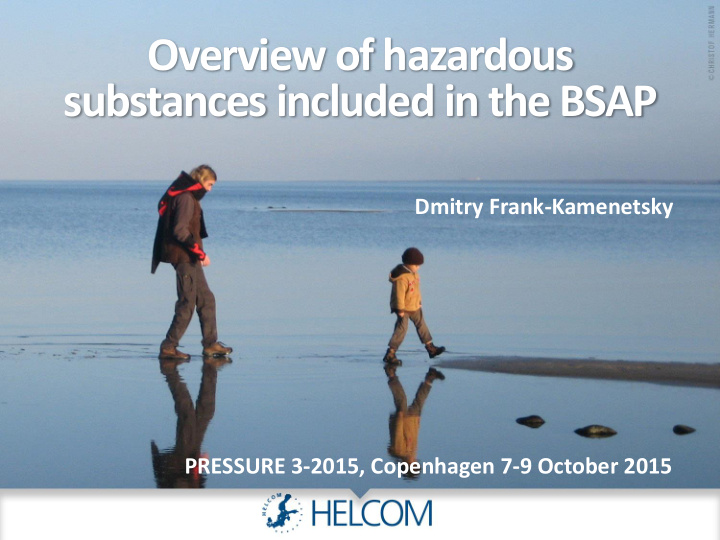



Overview of hazardous substances included in the BSAP Dmitry Frank-Kamenetsky PRESSURE 3-2015, Copenhagen 7-9 October 2015
Hazardous substances in BSAP The agreed goal of HELCOM on hazardous substances is a Baltic Sea undisturbed by hazardous substances. The goal is described by the ecological objectives: - Concentrations of hazardous substances close to natural levels, - All fish safe to eat - Healthy wildlife The list of substances or substance groups of specific concern to the Baltic Sea was established.
HELCOM RECOMMENDATION 31E/1 Adopted 20 May 2010, IMPLEMENTING HELCOM’S OBJECTIVE FOR HAZARDOUS SUBSTANCES ATTACHMENT 2 Appendix I List of substances of possible concern (to be further developed and completed on basis of the list of potential substances of concern to be considered by HELCOM, as contained in Recommendation 19/5 and Annex I of the Helsinki Convention) Appendix II List of Priority Hazardous Substances (to be updated)
Ministerial commitments - monitoring and assessment of airborne inputs and development of measures addressing airborne transport of hazardous substances; - encouraging continued research on hazardous substances of specific concern to the Baltic Sea, - assessing the need for joint measures to reduce emissions and discharges of hazardous substances; - making use of information generated by REACH Regulation, EU WFD and EU MSFD
Ministerial commitments - early ratification of the UNEP 2013 Minamata Convention on Mercury, as well as a quick start of the implementation of the Convention, taking into account existing and possibly updated HELCOM Recommendations limiting the use of mercury in products and processes; - the agreement to establish combustion efficiency requirements and/or emission limit values for dioxins according to HELCOM Recommendation 28E/8 by 2016 in order to minimize dioxin emissions from small-scale combustion sources as well as develop cost-efficient and BAT measures to large-scale industrial sources;
HELCOM core indicators Core indicators form the critical set of indicators which are needed to regularly assess the status of the Baltic Sea marine environment. Lena Avellan
Core indicators Based on State&Conservation 2- Indicator name 2015 and Gear 11-2015* Hexabromocyclododecane (HBCDD) Agreed on GES Cadmium Agreed on GES Mercury Agreed on GES Polybrominated biphenyl ethers (PBDE) Agreed on GES Perfluorooctane sulphonate (PFOS) Agreed on GES Polychlorinated biphenyls (PCB) and dioxins and furans Agreed on GES Tributyltin compounds (TBT) and imposex GES-boundary not yet proposed Estrogenic-like chemicals and effects Keep as pre-core Nonylphenols (NP); Octylphenols (OP) Not included in BSAP Lead Agreed on GES Polyaromatic hydrocarbons (PAH) and their metabolites No agreement on GES
2 nd holistic assessment: HELCOM Baltic Sea Action Plan (BSAP) follow-up 1) Distribution of main pressures and impacts on the Baltic Sea. 2) Integrated assessments of Biodiversity, Eutrophication and Hazardous substances. 3) Economic and social analyses in support of regional approaches to assess the use of marine waters and cost of degradation. Baltic Sea unaffected by Favourable status of Baltic Sea EUTROPHICATION BIODIVERSITY MARITIME ACTIVITIES in the Baltic Baltic Sea undisturbed by Sea carried out in an environmentally HAZARDOUS SUBSTANCES friendly way
Programme of Measures In June 2014 HELCOM HELCOM Gear Group initiated a process to take stock of the implementation by the Contracting Parties of the existing HELCOM acquis. The Intersessional Group on Programmes of Measures (IG PoM) has developed a draft document on regional coordination of Programmes of Measures. The Meeting further noted that the next meeting of Pressure Group plans to provide input regarding inputs of hazardous substances to the regional coordination of measures.
Substances Used/banned Indicator Status assessment Input assessment 1. Dioxins (PCDD), furans Combustion Core indicator assessment 2010, sub GES EMEP monitoring (PCDF) & dioxin-like product No GES agreed status polychlorinated biphenyls 2a. Tributyltin compounds Prohibited Core indicator assessment 2010, variable no data (TBT) 2b. Triphenyltin No GES agreed data compounds (TPhT) 3a. Pentabromodiphenyl ether Prohibited Core indicator data are available, GES no data (pentaBDE) 3b. GES agreed exceeded Octabromodiphenyl ether (octaBDE) 3c. Decabromodiphenyl ether (decaBDE) 4a. Perfluorooctane sulfonate restricted use Core indicator tentative evaluation in no data (PFOS) 4b. Perfluorooctanoic GES agreed, 2013 shows GES acid (PFOA) 5. Hexabromocyclododecane used Core indicator tentative evaluation 2013 no data, (HBCDD) GES agreed show GES substance flow analyses shows emissions of 300-700 kg/year 6a. Nonylphenols (NP) 6b. restricted use pre-core no assessment no data Nonylphenol ethoxylates indicator (NPE) no GES agreed
7a. Octylphenols (OP) 7b. used pre-core indicator no assessment no data, Octylphenol ethoxylates no GES agreed Substance flow analysis (OPE) estimation varies from 18,000 kg/a to 75,000 kg/a. Major source is car tyre abrasion. 8a. Short-chain chlorinated banned or no status no assessment no data paraffins (SCCP or limited chloroalkanes, C10-13) 8b. Medium-chain used no status no assessment no data chlorinated paraffins (MCCP or chloroalkanes, C14-17) 9. Endosulfan banned no status no assessment no data main source is LR transport 10. Mercury restricted Core indicator tentative evaluation 2006- EMEP monitoring GES agreed 2011 indicate concentrations close to the targets 11. Cadmium restricted Core indicator tentative evaluation 2013 EMEP monitoring GES agreed show sub-GES for some points
Not included in BSAP Lead Core indicator tentative evaluation EMEP monitoring GES agreed 2005-2010 indicate concentrations in some areas exceed GES. Polyaromatic Core indicator Low concentrations of EMEP monitoring hydrocarbons (PAH) No GES Benz/a/pyrene were and their metabolites agreed indicated (benz/a/pyrene)
QUESTIONS Is the current assessment (e.g. frequency and completeness of the information on air deposition) of the environmental pressure caused by emission of hazardous substances sufficient for the purposes of the second holistic assessment? What are urgent needs in the assessment of emissions of particular pollutants, identifying possible sources of information? Do any existing HELCOM Recommendations, including the list of priority substances, need to be updated?
DECISIONS measures aimed at reduction of input of hazardous substances to the Baltic Sea which can be suggested for coordinated implementation in the HELCOM region; pollutants, which airborne inputs have to be assessed in order to complement the holistic assessment of the health of the Baltic Sea with data on environmental pressure; the periodicity of reporting data on different pollutants by EMEP
Recommend
More recommend